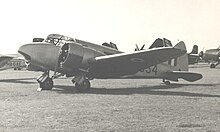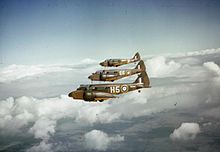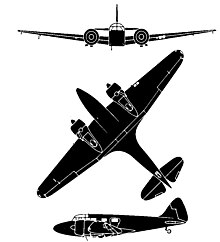|
Airspeed Oxford
The Airspeed AS.10 Oxford is a twin-engine monoplane aircraft developed and manufactured by Airspeed. It saw widespread use for training British Commonwealth aircrews in navigation, radio-operating, bombing and gunnery roles throughout the Second World War. The Oxford was developed by Airspeed during the 1930s in response to a requirement for a capable trainer aircraft that conformed with Specification T.23/36, which had been issued by the British Air Ministry. Its basic design is derived from the company's earlier AS.6 Envoy, a commercial passenger aircraft. After its maiden flight by Percy Colman on 19 June 1937, it was quickly put into production as part of a rapid expansion of the Royal Air Force (RAF) in anticipation of a large-scale conflict. As a consequence of the outbreak of war, many thousands of Oxfords were ordered by Britain and its allies, including Australia, Canada, France, New Zealand, Poland, and the United States. Following the end of the conflict, the Oxford continued to achieve export sales for some time, equipping the newly formed air forces of Egypt, India, Israel, and Yugoslavia. It was considered to be a capable trainer aircraft throughout the conflict, as well as being used as a general-purpose type. A number of Oxfords are preserved today on static display worldwide. DevelopmentDuring the 1930s, a major expansion of the Royal Air Force (RAF) had been directed by the British government, which led to the formulation and issuing of a number of operational requirements by the Air Ministry.[3] One of these was Operational Requirement 42 (OR.42), which sought an advanced training aircraft to be specifically used by aircrews destined to serve on bomber aircraft. As the RAF was in the process of migrating from biplanes to monoplanes, which were capable of greater speeds and had more demanding flight characteristics, a suitable trainer was needed to match this step change.[1] At one point, the Avro Anson was considered for the role, however, it was thought that an aircraft more difficult to fly would be necessary. Accordingly, on 10 July 1936, Specification T.23/36 was issued to Airspeed for the development of a twin-engined training aircraft to meet OR.42.[4]  Developed to meet the requirements of Specification T.23/36 by Airspeed, the Oxford was based on the company's existing commercial 8-seater aircraft, the AS.6 Envoy, designed by Hessell Tiltman. Seven Envoys had already been modified for the South African Air Force (SAAF) as the "Convertible Envoy", which could be equipped at short notice with bomb racks and with a machine-gun in a hand-operated Armstrong Whitworth dorsal turret. Airspeed gained substantial benefit from its prior work on the Envoy and the Convertible Envoy in its development of the Oxford.[3] The Air Ministry approved of the project, leading to an initial order for the type being placed during 1937.[1] It was decided to opt for a large first batch, totalling 136 aircraft, as this allowed for the implementation of more economical flow-line production at Airspeed's Portsmouth factory.[5] On 19 June 1937, the first prototype Oxford, L4534, was first flown by chief test pilot C H A 'Percy' Colman from Portsmouth. Initially, two variants were planned; the Mark I, which was viewed as a general-purpose training aircraft equipped with a dorsal gun turret, and the Mark II, which lacked any turret but was instead fitted with dual controls.[3] As further large contracts for the aircraft were placed with Airspeed, (100 Mk Is and 100 Mk IIs) it was arranged that de Havilland Aircraft would build them at Hatfield later, to meet the demands for Oxfords for training. Other companies also manufactured the aircraft.[4][3] By the end of production, a total of 8,751 Oxfords had been completed.[1][2] Of these, 4,411 had been produced by Airspeed at its Portsmouth factory, another 550 at the Airspeed-run shadow factory at Christchurch, Dorset, 1,515 by de Havilland at Hatfield, 1,360 by Percival Aircraft at Luton and 750 by Standard Motors at Coventry.[6][N 1] Design The Oxford was a low-wing twin-engine cantilever monoplane, featuring a semi-monocoque constructed fuselage, a conventional landing gear configuration and a wooden tail unit. It was capable of reproducing the flight characteristics of many contemporary front-line aircraft then in military service.[3] It was specifically developed to be suitable for a range of training missions, including navigation, flying instruction, night flying, instrument flying, wireless, direction-finding, gunnery, and vertical photography.[3] The Oxford was specifically planned and developed to incorporate various modern innovations and equipment fittings, including a full array of instruments and controls within the cockpit, which assisted in its principal trainer role.[3] In addition, the Oxford could also be used in various secondary roles, such as an air ambulance and maritime patrol aircraft.[8][3] In terms of flying experience, the Oxford was suitably representative as to enable pilots to migrate onto larger transport aircraft with ease while possessing smooth flight characteristics.[9] The controls were relatively straightforward, typically remaining consistent and easily adjustable; the second pilot's position is also provided with a fully furnished suite of key flight instrumentation. It was equipped with the standard blind-flying panel, incorporating an airspeed indicator, altimeter, artificial horizon, directional gyroscope, rate of climb indicator and turn indicator.[10] Life support equipment includes three oxygen regulators, a flowmeter, three bayonet unions and three high-pressure oxygen cylinders of 750 litres capacity.[11] The external view of the cockpit was considered to be very high for the era, superior to the majority of its contemporaries, but is unavoidably interrupted by the engine cowlings acting as blind spots.[12] It was normally operated by a three-man crew; the seating arrangement could be altered in order to suit various purposes, such as to better enable a specific training role. The cockpit was outfitted with dual flying controls and a pair of seats, intended to accommodate a pilot and either a navigator or second pilot alongside. When used for bomb aimer training, the second set of controls would be removed and the freed-up space was instead used to accommodate a prone bomb-aimer.[8] When used as a navigation trainer, the second seat was pushed back so that it would line up with the chart table.[10] Aft of the cockpit was a wireless operator station, facing aft on the starboard side of the fuselage. On the Oxford I, a dorsal turret was located amidships; it could be used for training navigators, bomb-aimers, wireless operators, air gunners and camera operators.[8] The centre section can contain up to 16 11 lb. practice bombs, which are controlled via bomb-release switches installed at the pilot and bomb-aimers' stations.[11]  The Oxford was normally powered by a pair of Armstrong Siddeley Cheetah X air-cooled radial engines, capable of generating 340 hp.[5] These were initially outfitted with wooden fixed-position de Havilland-built propellers, but had been designed from the onset to accommodate variable-pitch propellers when these became available. However, only 199 (Mk.V) were actually equipped with variable-pitch propellers, but all Oxford cockpits contained a propeller pitch lever, allowing an instructor to insist it was moved from "Coarse" to "Fine" for landing to reinforce this important step for trainee pilots.[13][14] The starboard engine drives a hydraulic pump and air compressor, the former being used to actuate the undercarriage and flaps while the latter is used for the braking system; a vacuum pump is also present for the gyroscopic instrumentations. The port engine drives a 500-watt electrical generator.[15] The engine cowling features an inlet that draws cooling air into a tank; a pair of tinned steel oil tanks are also contained within the cowling. Welded steel construction was used for the nacelles, which attach to the centre section of the wing at four separate rubber-insulated joints.[5] The retractable undercarriage of the Oxford was internally designed, featuring broken-braced twin oleo legs that retract rearward into each engine nacelle.[5] Although actuation of the retraction mechanism is normally achieved via an engine-driven pump, a manual fall-back mechanism is provided to force the wheels down in the event of an in-flight engine failure. The undercarriage wheels are equipped with pneumatically-operated brakes, controlled by a lever set on each control column.[5] For inspection purposes, access panels are located beneath the pilot's cockpit for internal access to the flight controls, hydraulics and electrical components; inspection panels are also present in the outer wing sections.[11] The semi-monocoque fuselage of Oxford uses an arrangement of spruce longerons and stiffeners underneath a plywood exterior.[5] It is constructed in two sections on separate jigs, divided between the front and rear, these are joined together at the rear bulkhead. The forward bulkhead is deliberately reinforced so that the structure is capable of withstanding the impact of the aircraft turning over during landing in the hands of an unfortunate trainee pilot.[5] Both the elevator and fin of the tail unit used a wooden spar and rib structure covered by fabric.[5] The fuselage can be partially dismantled, the wing dividing into three separate sections, so that it can be road-transported. The wing uses a stressed-skin ply-covered structure using spruce flanges and ply webs.[5] The spars are assembled upon a single jig, while others are used for the elements of the leading edge and trailing edge. Similar construction to the centre section is also used in the outer panels.[5] The wings are outfitted with hydraulically-operated split flaps, which extend between the ailerons.[5] Operational history  The Oxford (nicknamed the 'Ox-box') was used to prepare complete aircrews for RAF Bomber Command and could simultaneously train pilots, navigators, bomb aimers, gunners and radio operators on the same flight.[16][1] In addition to training duties, Oxfords were used in communications and anti-submarine roles and as air ambulances in the Middle East.[citation needed] The Oxford was the preferred trainer for the Empire Air Training Scheme and British Commonwealth Air Training Plan (BCATP), with over 2,900 sent to Commonwealth countries; Australia, Canada (where the majority of training was carried out), New Zealand, South Africa, and Southern Rhodesia. 27 Oxfords were on the strength of No 4 Flying Training School RAF Habbaniya, Iraq in early 1941 and some were converted locally for use as light bombers to help in the defence of the School against Iraqi forces.[17] Oxfords continued to serve the Royal Air Force as trainers and light transports until the last was withdrawn from service in 1956. A small number of ex RAF Oxfords were converted to civilian use post-war, along with 152 more that were converted into 6-seat commercial airliners called the AS.65 Consul. Meanwhile a fair number of surplus RAF aircraft were sold for use by overseas air arms, some as early as 1943, but mostly post-war. (see below) Most Oxfords in the UK were equipped with a knotted rope from the pilot's seat to the rear door to assist evacuation should the plane inadvertently be put into a spin, which it was almost impossible to recover from. When the pilot(s) released their seat belts centripetal force would hurl them to the rear of the plane, beyond the exit door, from which it was impossible to crawl forward to the door. The rope was installed as a response to a test by four "boffins" who tried to recover from a spin from 18,000 ft. When no recovery happened no matter what was tried the four released their harness and were hurled to the rear of their plane and there remained helpless as the spiral descent continued. However all was not lost. The plane was in such a flat spin when it reached the ground that it skidded sideways over the surface of a field until the tail section hit a haystack and broke off. The four "boffins" walked away relatively unharmed, the knotted rope being their only positive remedy for an Oxford in a spin. AustraliaFrom November 1940, the Royal Australian Air Force received 391 Oxford I and IIs from RAF contracts for use in Australia.[18] Most of the survivors were sold in the early 1950s.[19] CanadaThe Royal Canadian Air Force ordered 25 Oxford Is in 1938. They were taken from RAF stocks and shipped to Canada in 1939 and assembled by Canadian Vickers at Montreal. Issued to the Central Flying School, they were later joined by large numbers of RAF aircraft to equip the Service Flying Training Schools.[20] 819 Oxfords of all Marks were operated by the RCAF in Canada for the BCATP during the war. New ZealandNew Zealand was one of the first nations to order the Oxford in 1937 with a contract for five Oxford Is; the fifth aircraft was modified as a survey aircraft. They were delivered to New Zealand by sea and assembled at RNZAF Hobsonville at the end of 1938. The RNZAF placed further orders for six and then 30 Oxfords. With the start of the Commonwealth Air Training Plan a further 140 aircraft were allocated, which included the last batch of 30 ordered.[21] In total, the RNZAF operated 299 Oxfords between 1938 and 1952. South AfricaAs part of the Commonwealth Air Training Plan, the South African Air Force was allocated nearly 700 Oxfords which started to arrive in South Africa from November 1940. Due to the intense training, 256 aircraft were lost to accidents. Most survivors were withdrawn in 1945 and had been sold by 1947.[22] United KingdomAmy Johnson's Final FlightIn January 1941, whilst flying an Oxford for the Air Transport Auxiliary (ATA), the aviator Amy Johnson flew off-course in adverse weather conditions, until her aircraft crashed into the Thames Estuary. Accounts vary, but it is generally accepted that she bailed out, then succumbed to the intense cold whilst in the water, and may then have been dragged underneath a rescue vessel. In difficult sea conditions, the Captain of the rescue vessel (Lt Cmdr Walter Fletcher) entered the water in an attempt to retrieve what was thought to be a body, but he lost consciousness in the extreme cold, and died in hospital several days later.[23] United StatesThe United States Army Air Forces (USAAF) used 137 Oxfords on loan from the Royal Air Force. Most were used as general-purpose communications aircraft in the United Kingdom; from June 1942 they were also used for Beam Approach training. By the end of 1944, American types were available, and all USAAF Oxfords had been returned to the RAF. A small number had also been loaned to the USAAF in Australia by the Royal Australian Air Force. Two Oxfords were used by the United States Navy in the United Kingdom as communications aircraft.[24] Other users
Variants
OperatorsSurviving aircraft

Specifications (Mk I) Data from Modern Trainer[10] General characteristics
Performance
Armament
See also
Related development Aircraft of comparable role, configuration, and era Related lists Notes
ReferencesCitations
Bibliography
External linksWikimedia Commons has media related to Airspeed AS.10 Oxford.
|
||||||||||||||||||||||||||||||
